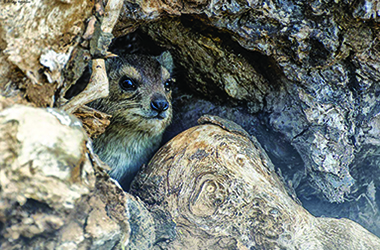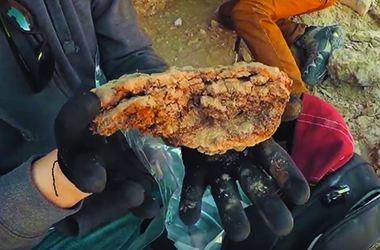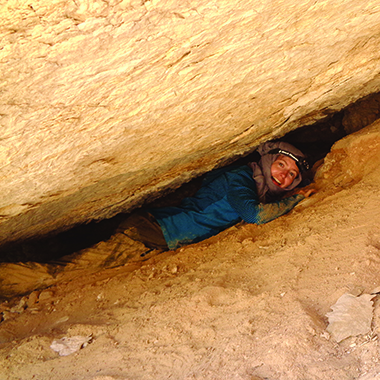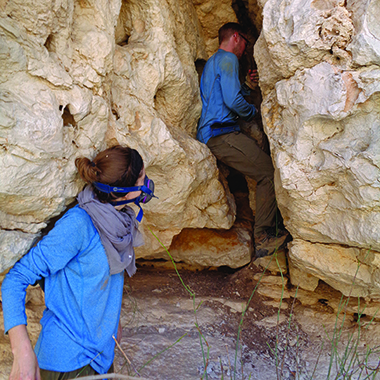
High on the craggy cliffs of Oman’s rocky desert landscape, Sarah Ivory squeezed into narrow, dark caves in search of a different kind of goldmine.
Shaded away from the desert sun, Ivory tapped a dusty, gray rock with her hammer and heard the dull, hollow sound she’d been waiting for.
She found a special kind of fossil that, when cut open, would reveal smooth golden-brown layers that can help scientists see deep into the past.
This was a fossil of a midden, a communal toilet used by generation after generation of a small, desert-dwelling animal. The same middens are sometimes used for tens of thousands of years.

Ivory recently journeyed to Oman, on the tip of the Arabian Peninsula, to find middens tucked in these caves, dig them out and ship them back to her laboratory at Penn State for analyses.
It’s a dirty job.
But in one of the driest places in the world, middens may be the best evidence to understand how the climate changed in the past, and how plants, animals and even humans, responded.
“These unusual fossils are one of the only ways we can look back into the past and see how arid areas changed over time,” said Ivory, an assistant professor of geosciences. “That can help us answer important questions about how they will change in the future. These regions are very sensitive to changes in rainfall and are very at risk.”
Creatures of habit
The deep, rocky valleys that cut through the Oman desert are home to the rock hyrax, which is, by all accounts, a strange animal.
 Hyraxes may look like oversized rodents at first glance, but the tiny tusks that protrude from their jaws hint at their closest living relative—elephants.
Hyraxes may look like oversized rodents at first glance, but the tiny tusks that protrude from their jaws hint at their closest living relative—elephants.
For tens of thousands of years, these animals have lived in colonies across sub-Saharan Africa and the Middle East. In Oman, hyraxes pop in and out of small caves that pock the steep valley walls like swiss cheese, going about their daily routine.
Hyraxes are creatures of habit, and many generations of entire colonies have used the same spots to urinate and defecate. Middens discovered in Africa have provided unbroken fossil records dating back as far as 40,000 years.
When hyrax urine meets the arid desert air, it crystalizes, creating a stinky, amber-like substance that provides fossil evidence of past climate change where none had been previously available, making their discovery a cause for celebration.
“The middens have a distinct smell, almost like incense,” Ivory said. “I think it’s one of those things where you develop associations with smells. Because to me they smell like victory.”
A window to the past
Troy Ferland never knew what he would find when he peered into the caves. The Penn State graduate student could come face-to-face with a snake or scorpion seeking shelter from the desert sun. On a good day, he would stumble upon an ancient midden site.
 “It’s a numbers game,” said Ferland, a doctoral candidate in the Department of Geosciences who traveled with Ivory on a research trip to Oman. “The more holes you poke your head into, the better the chances you’ll find a midden.”
“It’s a numbers game,” said Ferland, a doctoral candidate in the Department of Geosciences who traveled with Ivory on a research trip to Oman. “The more holes you poke your head into, the better the chances you’ll find a midden.”
In Oman, the place to look is between the coast, where wet conditions may prevent middens from being preserved, and the open desert, where food for hyraxes is scarce.
Still, finding middens is not an exact science, especially for researchers more used to working with core samples drilled near lakes and bogs than with crawling through dry, dusty caves.
“This research is really important, because middens are one of our best tools for figuring out how arid and semi-arid areas changed in the past,” Ivory said. “There are no lakes or bogs in these areas today, and traditional methods just won’t work.”
As middens form over long periods, tiny bits of pollen and leaves and traces of animals blow in on the wind and get trapped in new layers of the fossil.
Scientists can split the middens and use them like a core sample, answering questions about what plants grew in the region at different points in the past, and what animals grazed there. Isotopes contained in the urine can even reveal how much rainfall Oman experienced, Ivory said.
“Through middens, we can see how this environment was changing,” Ferland said. “We can see how vegetation changed throughout different periods of human occupation, how things like the introduction of grazing animals changed the landscape.”
Understanding the impacts of a changing climate is critical in Oman. The dry, rocky country has expanded rapidly over the last several decades, further compounding the country’s water scarcity concerns.
“We should care about what’s happened to Oman in the past, because we have a changing climate right now,” Ivory said. “We don’t have observations beyond the last couple of decades to know how Earth’s climate will change and how plant communities are likely to respond to that and what changes in our ecosystem there might be. We can answer some of those questions by looking deep into the past, and middens are one way to do that.”

